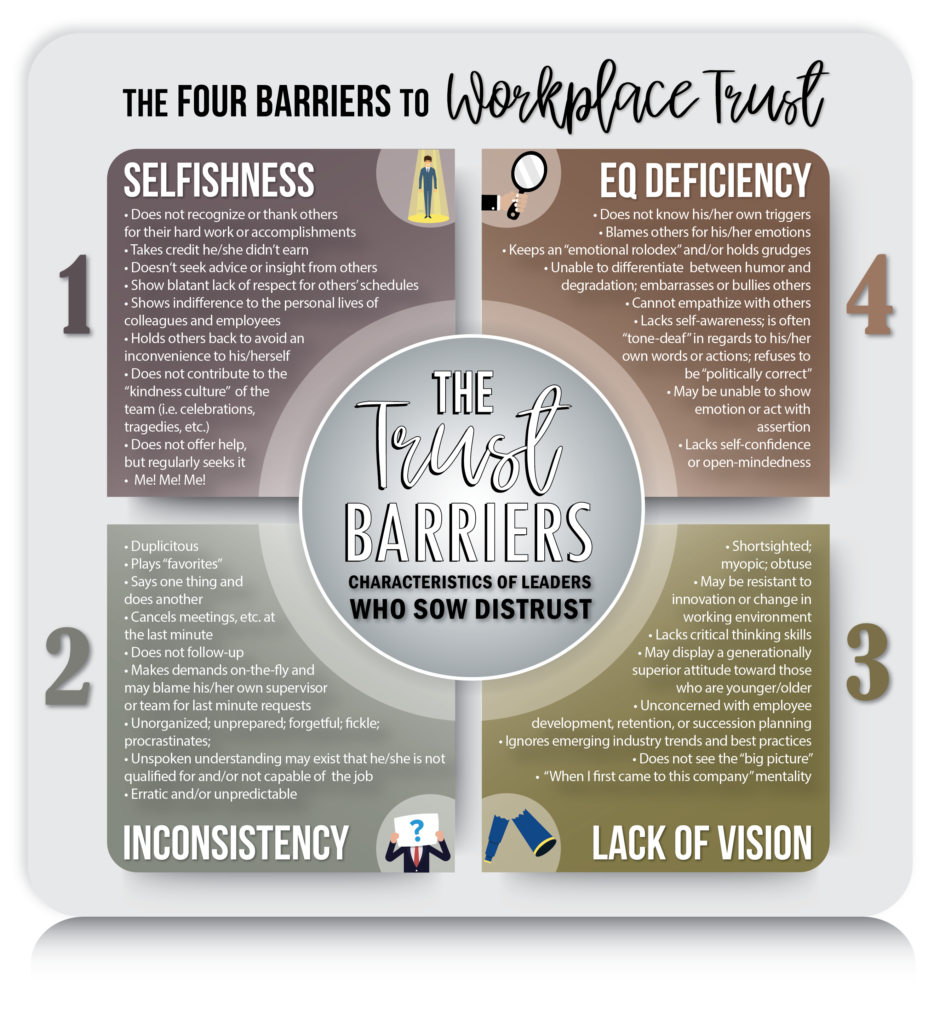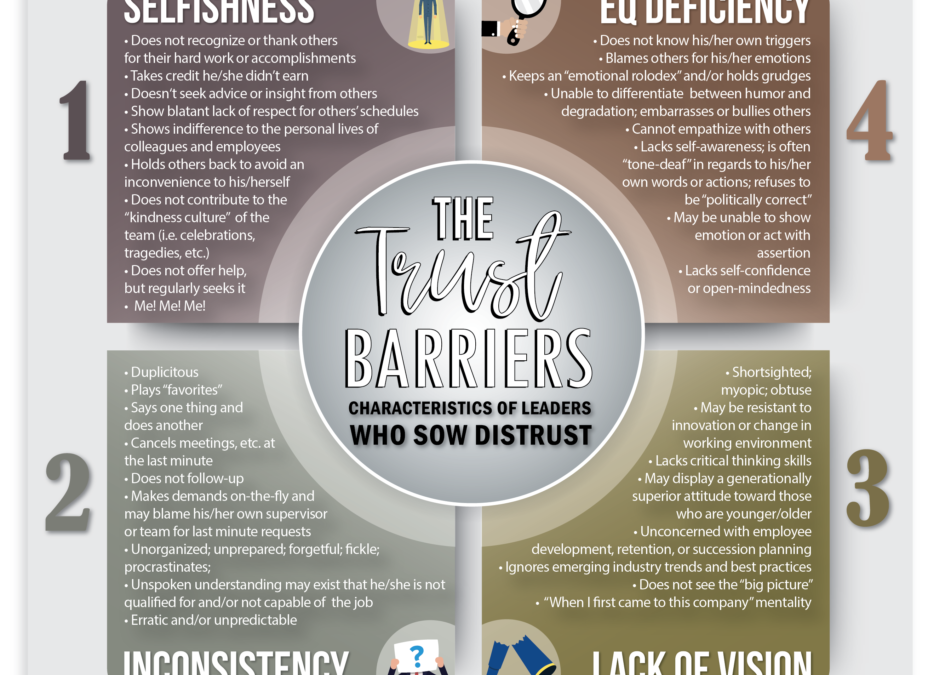Trust Breakdown: Four Things Leaders Do that Deteriorate Trust by Alice P. Stapleton, MSL | Guest Blogger
According to Tolero Solutions, a career and workplace culture think-tank, 45% of people say lack of trust in leadership is the biggest issue impacting their work performance, while as many as 65% of employed individuals are actively seeking a new job. But, why?
The large majority of these employees, when surveyed, attributed their unhappiness in the workplace to bad management – or more specifically, leadership that is lacking in one or more ways. In other words, employees, regardless of industry, are exhibiting an immense lack of trust in the individuals and leadership teams that are guiding their work, their departments, and their organization’s direction.
There are many specific ways in which management creates an environment of discourse and drudgery, but ultimately the woes of the workplace can be summed up simply and succinctly: they do not earn, foster, or maintain the trust of their employees. Part II of this series introduced the Trust Tetralogy, which describes the four crucial ingredients that are present and mutually exchanged between leaders and their colleagues: effective communication; cultivation of success; transparency; heart. Later in the series, we will look at several ways in which managers can proactively cultivate and sustain the trust of those they lead.
But first, it’s necessary to engage in a bit of self-awareness; to shed light on actions and attitudes that are responsible for the erosion of trust. The Five Barriers to Trust outlines the fundamental ways in which we undermine the promise to make honesty, fairness, and integrity – that is, TRUST – the cornerstone of our workplace culture. Then, in Part IV, we will look at real-world techniques you can use to proactively manage these behaviors in your boss, rise above bad attitudes displayed by teammates, and most importantly, make sure you proactively engage in the destruction of The Five Barriers.
Barrier #1 – A Self-Serving Agenda (aka “Selfishness”)
Leaders who struggle to gain the trust of those around them are often labeled as “selfish,” or “egotistic.” We all know someone who does not consider how their actions affect those around them. When we make decisions, or conduct business in a way that suggests that only our own prosperity or failure matters, we will absolutely erode the faith our team has in us.
Teams are not teams if all parties are not considered when big (and small) decisions are made. Our employees and colleagues work as hard, if not harder, than we do. We must always keep them at the forefront of core business practices: planning and decision-making; praise and recognition; and opportunity for growth and change. Expecting your employees to value their work if you do not value it exponentially more is neither logical or reasonable.
Additionally, good leaders never ever take credit for the work of others. The best leaders do not take even 50% of the credit for a job well done. Those deserving of trust from their teams know that acknowledging the productivity, innovation, and commitment of others will ultimately reflect positively on themselves – so there is no need to stake claim on the proverbial mountain of success.

Distrust in the workplace can most often, be associated with one of these four negative characteristics and behaviors displayed by some leaders.
Barrier #2 – Inconsistency
Little frustrates employees and teams more than when a supervisor is inconsistent in his/her management practices. Cohesion among colleagues is crucial to a well-oiled workplace. If for no other reason than the legal implications that can result from unfair labor practices, everyone should be consistent in how they manage day-to-day employee engagement.
But as important is the myriad of problems that can arise when supervisors are less than predictable when it comes to performance expectations, employee recognition, raises, promotions, and coaching. Good managers treat their employees equally, set reasonable expectations, follow-up with a sense of urgency, and act in an unsurprising and predictable way.
But perhaps, the greatest inconsistency that often occurs among the ranks of management is the one that relates to duplicity in the workplace. Nothing is more frustrating to employees (and rightfully so) than the supervisor who is quick to reprimand his/her reports, for example, for arriving late or leaving early, when he/she is regularly the last to show up to work, and the first to leave.
Barrier #3 – Shortsightedness
There are many reasons that those in positions of power earn the honorary title of “leader,” but one of their most distinguishing traits is vision. If those at the top do not have a clear understanding of why themselves and others are working for a common purpose – i.e. vision, mission, goals, company values, etc. – then the leadership pipeline will break, and the pillars of trust will ultimately collapse.
Employees give trust to those they wish to emulate. The best visionaries know they do not need to be the smartest person in the room. In fact, they surround themselves with people who are better than themselves. They understand that a large part of their job is acting as the democratic head of a team that is made up of subject matter experts instead of seeing their role as the chief know-it-all who simply gives unilateral orders.
A good leader makes certain, through his/her vision for continued growth and productivity, that his/her team has a bright, sustainable future as contributors to the company’s success. Myopic managers, who have difficulty creating a meaningful workplace culture, seeing the big picture, or planning for the future, are likely to be seen as unfit by their colleagues and employees.
Barrier #4 – Emotional Intelligence (EQ) Deficiency
Jack Welch, one of the best known CEO’s in American History and decades long leader of General Electric once said, “No doubt emotional intelligence is rarer than book smarts, but my experience says it is actually more important in the making of a leader. You just can’t ignore it.” GE is forever impacted by Welch’s footprint, and this is not only due to his unmatched talent as a visionary and innovator. His success, and GE’s worldwide impact on corporate culture and change management practices was largely due to Welch’s comprehension and practice of emotional intelligence (EQ).
Dozens of studies performed by reputable sources around the world have shown time and again that EQ is crucial to individual and company success. In fact, 90% of top performers in today’s workplace are credited with having a high EQ. Further, of them, 70% have only average IQ’s, thereby making a strong argument that EQ is ultimately far more important than one’s intelligence. (Talentsmart.com)
So what is EQ? Howard Gardner, the influential Harvard theorist, defines EQ as, “one’s level of ability to understand other people, what motivates them, and how to work cooperatively with them.” There are five categories that make up EQ; self-awareness, self-regulation, motivation, empathy, and social skills. Unlike IQ, EQ is malleable – it can be molded, enhanced, and developed over time. That is good news for the supervisor who suffers from an EQ deficiency, but those working for managers who are void of EQ are likely to develop a strong distrust in him/her. This is an appropriate reaction, since an absence of EQ can result in a person behaving in hurtful, even harmful, ways. For example, managers who do not possess EQ may:
- Be hyper-reactive or hypersensitive.
- Be unable to express emotions or act with assertion.
- Keep an “emotional rolodex” or hold grudges.
- Not know his/her own triggers.
- Blame others for the way he/she feels.
- Feel constantly threatened or as if his/her job is in jeopardy.
- Lack self-confidence or open-mindedness.
- Be unable to draw a line between humor and degradation.
- Engage in language or actions that are unacceptable and justify them in unacceptable ways.
In Part IV, we will discuss EQ in more detail, including resources for EQ training and development.
Any time you read about leadership qualities, it is important to remember that ultimately, the well-informed author is referring to you. Remember the first barrier, a self-serving agenda, and make note of the manner in which you read this article. Did you imagine your own boss? Was there a teammate who kept running through your mind? Even subconsciously? Or, did you think about yourself, and how you might be building barriers to trust? Answering yes to these questions is the right response, but your own construction of pillars and destruction of barriers is the only real aspect of trust leadership you can control. So, the lesson?
First, concentrate on yourself, and your own commitment to growing as a trust leader. Once you’ve crawled atop your own trust-barrier-wrecking-ball you’ll be able to concentrate on how you can encourage others to do the same.
The Lesson
Any time you read about leadership qualities, it is important to remember that ultimately, the well-informed author is referring to you. Remember the first barrier, a self-serving agenda, and make note of the manner in which you read this article. Did you imagine your own boss? Was there a teammate who kept running through your mind? Even subconsciously? Or, did you think about yourself, and how you might be building barriers to trust? Answering yes to these questions is the right response, but your own construction of pillars and destruction of barriers is the only real aspect of trust leadership you can control. So, what’s the lesson? First, concentrate on yourself, and your own commitment to growing as a trust leader. Once you’ve crawled atop your own trust-barrier-wrecking-ball you’ll be able to concentrate on how you can encourage others to do the same.

